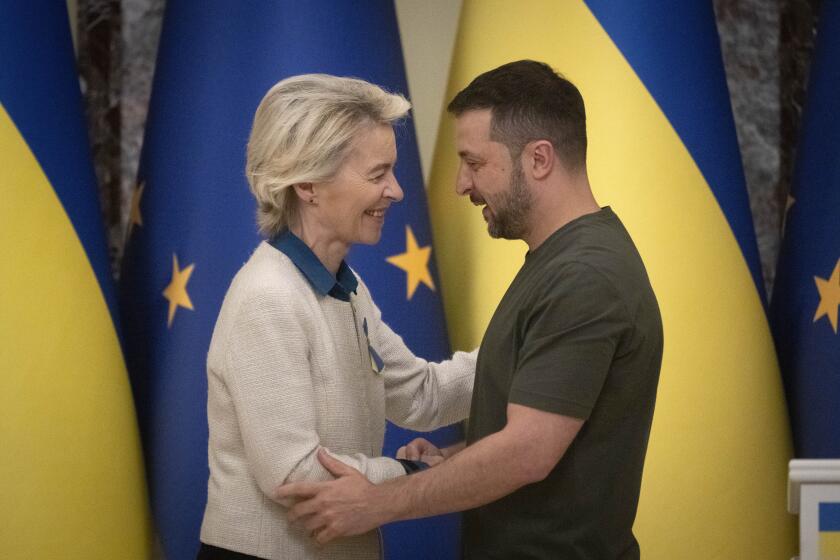Young India golfers take swings at poverty
KOLKATA, India — Fourteen-year-old Mohan Sardar lives with his sister and parents in a one-room shanty barely larger than the bed they all share, near a swamp filled with human waste, dead animals and floating plastic.
When he was in the fifth grade, Mohan dropped out of school because his family couldn’t afford the fees. At loose ends, he often walked two miles to the Royal Calcutta Golf Club — “the Royal” to members — scrambling atop a wall and marveling at the vast green expanse and wealthy players.
Founded by the British in 1829, the golf course features the Signature clubhouse, where continental grilled prawns for two cost what would be a week’s wages for Mohan’s father. A nearby notice board asks members to use colored towels for their feet, white for their bodies, and a motivational banner reads: “Uncap the Bold and Beautiful Spirit.”
One day Mohan befriended a golfer, asking whether he needed a caddy. He earned $1.50 the first day, gave most of it to his mother, and they ate fish that night. “It was brilliant,” he said.
The golfer’s coach started giving Mohan pointers and he was soon playing the occasional round of a sport that enjoys a particularly elite status in India, especially among nouveau riche Indians clamoring to mark their arrival.
Today, Mohan, a lanky boy with short hair and deep-set eyes, has a golf handicap of three and is among India’s top five junior players.
***
Among the 3 million or so charities operating in India, “golf for the destitute” wouldn’t exactly top the list of pressing social needs.
The way pro golfer Indrajit Bhalotia sees it, however, offering hope of a life-changing career for a few has a place alongside meeting the temporary needs of multitudes.
Bhalotia, 40, confident and understated, born into a well-off family, started playing golf at 4. He became India’s top-ranked player in 1990 and founded ProTouch Golf Academy, selling equipment, apparel and lessons to the well-heeled.
During a slump in 1998, hoping to get his winning form back, he pledged 10% of his future winnings to charity. Eventually he decided that wasn’t enough, that anyone could give money but he needed to do more.
“Golf’s been very good to me,” he said recently at the Royal. “It’s the least I could do. There was karma for me in this.”
He started recruiting impoverished children through Ek Prayaas, a Kolkata charity, and among the club’s caddies. A lifetime spent whacking small white balls allowed him to spot aptitude within minutes of their first swing.
“Sure, I might miss one Tiger Woods,” he said. “But out of five, I can pick out four.”
Using ProTouch instructors, he’s coaching 20 underprivileged children with plans for 80 more. With help from some wealthy friends, Bhalotia covers equipment and travel expenses for the most promising youngsters to compete on the junior circuit, ages 10 to 15. They are all boys at this point although one girl is learning quickly and could soon join their ranks. One of the boys just qualified for the Callaway Junior World Golf Championships in San Diego next week.
Their school fees are also covered, with expenses amounting to about $2,000 annually for each of the children, including Mohan, who returned to school after three years away. The caveat: The children must contribute some modest amount themselves to ensure that they value the program.
“There are five to seven kids I can take on to even win theU.S. Open,” Bhalotia said.
Because they’re so hungry to escape crippling poverty, they work much harder than silver-spoon youngsters, said Bhalotia, who confesses that he tears up whenever one wins a tournament.
For producing young champions, ProTouch also receives favorable publicity.
“I don’t want to sound like I’m Mother Teresa,” Bhalotia said.
Some Indians say the money could be better spent elsewhere.
“I think it’s better to give 1,000 kids food than make one a golfer,” said Geeta Kharb, a designer from Noida, outside New Delhi, whose teenage son plays golf. “And look at the water these places waste.”
For the kids in Bhalotia’s program, perfecting their shots is easier than bridging the social divide with members of the Royal, which allows them to use its course during off-peak times.
Golf is an extremely rarefied sport in India, with just 200 courses — California has 1,140 — only one or two public courses nationwide and a 10-to-25-year waiting list to join exclusive private clubs.
“Many are like palaces, very intimidating to the common man,” said Vivek Mehta, country head at Callaway Golf India. “And those who play are probably among the richest players in the world. There’s a lot of spending capacity, and they like to flaunt it.”
Just outside the Royal’s gates, Manohar Purkait, who’s in his 60s, sells hard candy and cigarette singles from a rickety kiosk, his “retirement plan” after decades scraping by as a caddy. “Out here, I’m free,” he said. “Inside, I barely feel free to speak.”
To avoid seeing the youngsters humiliated, Bhalotia schools them in table manners and ensures that they’re well-dressed.
“He taught me to use a fork and spoon,” said Mohan, who prefers eating with his hands, as do many Indians. “I can do it, but it’s not comfortable.”
Although some Royal members no doubt wish the youngsters weren’t there, fear of unfavorable publicity probably prevents them from ending the program. Bhalotia said he’s careful to keep the number of youngsters down and their profile low.
“They’re not allowed to come to the clubhouse, so the members don’t get concerned,” said M.M. Singh, the club’s chief executive.
***
Back at Mohan’s Majhartaala slum, ringed with shacks of twisted metal and scrounged bricks, word of his success has inspired neighborhood youngsters who were busy recently putting a battered golf ball across the uneven dirt, careful not to lose it in the swamp water.
Mohan’s parents, subsistence farmers from a village south of Kolkata, migrated here when he was 2 looking for a better life. Today, his father earns $45 a month pedaling a rickshaw 12 hours a day.
They live in a smaller house amid more pollution than they had in the village. But there’s a sense of community here, Mohan’s parents say, more opportunity for their children and a lot less backbiting.
Just outside their house — the bed and dresser all but fill the 8-by-8-foot room ringed by palm-leaf walls bearing images of Hindu gods in cheap frames — several young laborers played cards after work as dusk approached, their boombox blaring dance music.
Elementary school student Pinku Das walked by with a putter resting on his shoulder. “I’ve been playing for two years,” the 8-year-old said. “I want to be a professional caddy someday.”
Since Mohan caught Bhalotia’s eye, he has played in nine tournaments, finishing fourth of 40 at a Bangalore event in May.
The proteges take inspiration from several emerging if not yet top-tier Indian golf pros, including Jeev Milkha Singh, Arjun Atwal and Jyoti Randhawa, who each have chalked up more than $6 million in international prize money. (The most famous golfer of Indian descent, longtime PGA Tour mainstay Vijay Singh, is a native of Fiji.)
Bhalotia describes Mohan as “quiet and reserved, but extremely confident on the golf course.” And Mohan says of his game: “Whenever I see a ball, I get an overwhelming urge to blast it.”
Before each tournament, Mohan touches his father’s feet to receive his blessing. He aches at the thought of his father pedaling on tired legs as he heads to hotels with rooms bigger than their house.
“It breaks my heart seeing my father pulling a rickshaw in all kinds of weather,” he said. “He always wishes me good luck, never complaining that I am wasting my time playing games.”
Neighbors caution against unrealistic expectations, but Mohan dreams of turning pro and winning big money, buying a house and paying for his sister’s wedding, traditionally an Indian family’s biggest expense.
His parents exude pride.
“I’ve never seen a course and have no idea about golf,” said his father, Asit Sardar, 38, wearing a traditional skirt-like dhoti. “But I’d love to see him play one day. All our hopes rest on him.”
More to Read
Sign up for Essential California
The most important California stories and recommendations in your inbox every morning.
You may occasionally receive promotional content from the Los Angeles Times.










